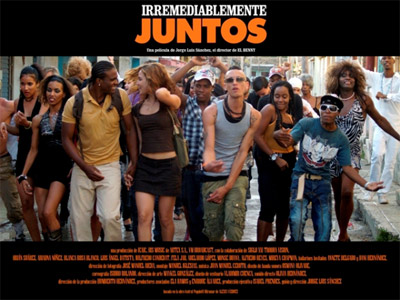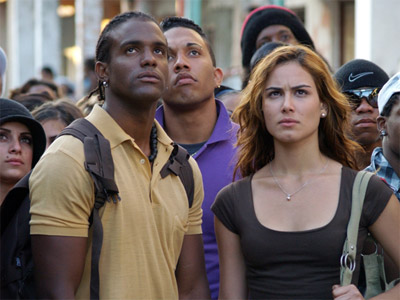Hopelessly Together, a New Cuban Film
Irina Echarry
 HAVANA TIMES — With the title Irremediablemente juntos (Hopelessly Together), theaters around Havana are showing the latest film by Jorge Luis Sanchez, who previously gave us his hit film El Benny and much earlier directed several important documentaries for the history of Cuban cinema.
HAVANA TIMES — With the title Irremediablemente juntos (Hopelessly Together), theaters around Havana are showing the latest film by Jorge Luis Sanchez, who previously gave us his hit film El Benny and much earlier directed several important documentaries for the history of Cuban cinema.
Based on Alexis Vazquez’s musical comedy for theater, Pogolotti-Miramar, Sanchez transformed the script into a drama (as he described on a recent television appearance) using the elements he liked while rejecting others that he didn’t – though all with Vazquez’s approval.
One thing he respected was the character of a musical presented in the work, which turns the film into a musical drama, a genre hardly explored in our country.
The protagonists: Alexander is a black man studying for a degree in physical education. He comes from a musical family and lives in the marginal Pogoloti neighborhood. Liz is a white university student from a well-off family that lives in the upscale Miramar community.
From the beginning, the director puts the issue on the table. When a history teacher recalls the slaughter of members of the Independent Party of Color in the early 1900s, the protagonists are challenged:
Alexander (at the sports school) says, “Everybody in my classroom is black, except for one girl.”
Liz (at the university) comments, “Everybody in my class is white, except for one guy.”

The film also criticizes class divisions. Each of them has a partner who supports them financially. Liz has a white boyfriend who works for an important company and who is desperate to get out of the tenement where he lives.
Similarly, Alexander has a black girlfriend who is a few years older than him, holds a high-level position in a hotel and wants to have children at all costs.
Other issues raised are those dealing with corruption, double standards and the stigma of marginality. But the approach to these issues is done in a sketchy manner, without an analysis of the problems or their impact on Cuban society.
The film plays with stereotypes. It uses them to emphasize that racism isn’t something of the past, as is said with irony by an official of the Ministry of Culture (Liz’s father) to a musician (Alexander’s father). Later, when the issue hits close to home, he rejects the black man.
But one has to be careful when playing with stereotypes, careful not to get caught up in them, because it’s difficult to get out of the tangle. Even here, the black man is shown as having to be a musician or an athlete, and the black woman with an important job has to act like she’s white in order to be successful.
In the film, success means having money and a good position; to succeed, people (of any race) go to babalawos (Afro-Cuban priests), and the black woman performs well in bed and leaves the white man enraptured. These are some dangerous topics that might confuse the viewer.
I know the intention was to make a stealthy critique of the racism that infects most Cubans, protected since 1959 in more subtle though equally damaging ways.
Nonetheless, if we consider that the actors are beautiful (a sweet and pretty white woman and a graceful, muscular black man), leaving out all those who don’t meet those standards, the film in itself becomes discriminatory.
I think the idea of the musical pales the true intention. It’s not that I’m against this genre, but it needed a more modern touch, such as in Dancing in the Dark.
In any case, among the audience were protests every time one of the actors began to sing, but people still identified with the film, though not so much with the drama that arose.
This is why on Sunday at the Yara Cinema, there was applause when Liz confronted her family and shouted that her boyfriend was black and laughter at the reaction of her family. Audience joy came when Liz’s ex-boyfriend gets married (before leaving to the United States) to a black neighbor who according to people, “qualified for the trip.”






Your review, as usually, is full of vitriol and by idiots/for idiots: ‘racism since 1959’ — not “before” LOL, ‘class divisions’ — ie by income/salary (hiding THE BANKERS, THE INDUSTRIALIST, THE OLIGARCHS of CAPITALISM)
I’d like to point out that I came to meet Jorge Luis Sánchez long before he became part of the Cuban Film Institute, when in the late 70s we were both cinema buffs, who would attend film debates at Havana’s Casa de la Cultura in Plaza District. At the time, there were no videocameras, or video at all, no HD, no DVDs, nothing…So we managed to churn out very primitive silent movies using old American or newer Soviet cameras, and resorting to Soviet-made 8 mm-film. Looking back and seeing Jorge Luis oeuvre today I must admit: You’ve come a long way, baby!
Something else: the current Cuban cinematographic aesthetics of today owe much to those debates and silent shorts patched together in the 70s and 80s. While Jorge Luis would uphold the line followed in the 60s by professionals such as the late filmmakers Sara Gómez and Guillén Landrián (which he still does today, making movies about blacks and the destitute and marginalized), Tomás Piard, the other amateur of the time who managed to make the crossover, would adhere to also deceased Humberto Solás’ (Lucia, The Rebel Youth) style, following in his steps by making historical (and sometimes hysterical) dramas that would typically focus on the Cuban average bourgeois or middle-class white family.
Carl:
Here it means that this last-minute girlfriend proved to be savvy enough to “catch” the man just as he was getting ready to leave the Island for foreign soil (US!)
What does “qualified for the trip” mean?